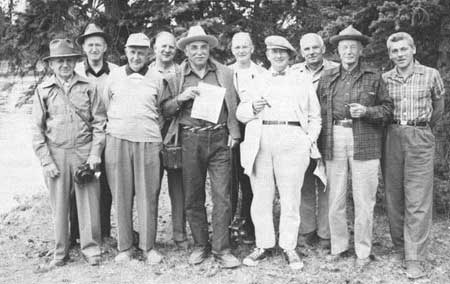|
Parks, Politics, and the People
|

|
|
Chapter 7: Other Emergency Period Programs HISTORIC SITES ACT OF 1935 The first section of the Historic Sites Act of 1935 reads, "That it is hereby declared that it is a national policy to preserve for public use historic sites, buildings and objects of national significance for the inspiration and benefit of the people of the United States." It is hard to figure how a policy could be written any simpler and yet cover such a broad, all inclusive purpose. The second section describes the duties to be performed by the secretary of the interior, through the National Park Service, in effectuating the policy expressed in the act. These duties are: collating data, surveys, etc. that illustrate United States history; carrying out investigations and research; acquiring property; protecting religious groups; providing for funds; and making cooperative agreements with other organizations and political bodies to restore, reconstruct, rehabilitate, preserve, and maintain historic or prehistoric sites, buildings, and objects. It further gives the secretary authority to provide tablets and markers, operate buildings, make contracts with concessionaires, conduct educational programs, establish rules and regulations, and define penalties for violations. Although the National Park Service had acquired historic sites and objects under the 1906 Antiquities Act, and the 1916 act establishing the National Park Service, the Historic Sites Act of 1935 spelled out and assigned definite responsibility for protecting and interpreting the history of man on this continent.
Section three provides for the establishment of the Advisory Board on National Parks, Historic Sites, Buildings, and Monuments to be composed of not more than eleven citizens of the United States, including representatives competent in the fields of history, archaeology, architecture, and human geography. They are appointed by the secretary. Shortly after the act became law a very talented group of people in various professional fields were appointed to the advisory board by the secretary. They had no set terms and they stayed on until they resigned or were replaced. It wasn't until the late forties that Secretary Oscar Chapman established staggered terms of six years for the members. The original board served the secretary and the National Park Service with distinction, and the committees of Congress depended to a great extent on its recommendations.
I believe Congress still relies on the board's advice, but, I am informed, to a lesser degree than formerly. In my opinion the reason is that people have been appointed who do not have the qualifications to make sound professional recommendations in accordance with the intent of the law. In fact, there have been several appointed for political reasons or for their contributions to political parties, possibly as a form of personal recognition for there is no salary attached to these appointments. I see no objection to politically oriented appointees as long as they are professionals qualified to fulfill the responsibilities of the office.
The Historic Sites act is of tremendous importance to the nation, and a good deal of credit is due to the National Park Service chief historian of that time, Dr. Verne E. Chatelain, for its effectiveness. I must make clear that while the act is referred to as the Historic Sites Act, the board's responsibility applied to the Park Service as a whole, not just to historic areas. Keep in mind that when the National Park Service was established, in 1916, there were fourteen national parks and twenty-one national monuments, seven of which dealt with history, three each in Arizona and New Mexico and one in Alaska. By 1933, before reorganization, the system had grown to sixty-six areas, of which forty-six were classified as natural areas and twenty as historic areas. The preceding table shows the increase in the number of areas in the national park system before and since the 1933 reorganization. The big expansion in the national park system and in state parks initiated in the CCC period was further encouraged by Mission 66; this program stimulated federal legislation for the preservation of natural and historic sites and promoted the development at all levels of government of historic, recreational, and natural areas. | ||||||||||||||||||||||||||||||||||||||||||||||||||||||||||||||||||||||
|
| ||
| <<< PREVIOUS | CONTENTS | NEXT >>> |
|
| ||
Parks, Politics, and the People ©1980, University of Oklahama Press wirth2/chap7a.htm — 21-Sep-2004 Copyright © 1980 University of Oklahoma Press, returned to the author in 1984. Offset rights University of Oklahoma Press. Material from this edition may not be reproduced in any manner without the written consent of the heir(s) of the Conrad L. Wirth estate and the University of Oklahoma Press. | ||

